In mid-1975 a jet departed Charleston, SC into an international picture. Twenty-six years later four fuel laden airliners emerged from that same picture and killed 3,000 innocent Americans. This is the painful story connecting the events.
If a tree falls in a forest: Part 1
On 29 July 1975 a Lockheed C-141 Starlifter cargo jet (below) took off from Charleston, South Carolina and turned slowly for the Atlantic Ocean. On board was a curious collection of cargo that few in the United States knew about. In distant Africa the aircraft was eagerly awaited. It was to be the first of several such flights.
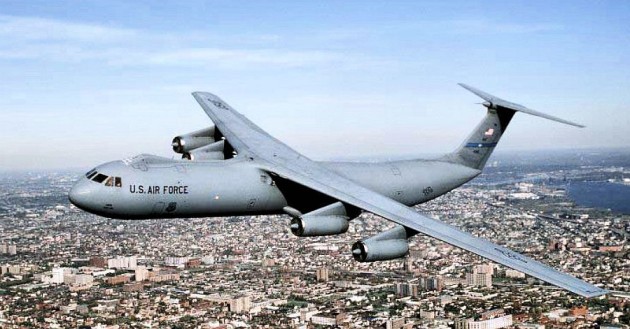 When the aircraft eventually landed, it was nighttime at N’Djili airport outside Kinshasa in the Congo. The “Belgian” Congo, or Zaire, as it was known in the 1970s, is a uniquely strategic country at the heart of Africa. It straddles the equator and borders no fewer than nine other African countries. Together with South Africa, it represents the key to the mineral wealth of Africa, a point that had not escaped Soviet leader Leonid Brezhnev. It has somehow always been the scene of the greatest horrors of Africa.
When the aircraft eventually landed, it was nighttime at N’Djili airport outside Kinshasa in the Congo. The “Belgian” Congo, or Zaire, as it was known in the 1970s, is a uniquely strategic country at the heart of Africa. It straddles the equator and borders no fewer than nine other African countries. Together with South Africa, it represents the key to the mineral wealth of Africa, a point that had not escaped Soviet leader Leonid Brezhnev. It has somehow always been the scene of the greatest horrors of Africa.
An observer at N’Djili would have been confused by the events on the ground around one of these C-141s on 20 October 1975. Two Lockheed C130 cargo planes (below) materialized from the southern night sky and, when they landed, some white men emerged. They wore plain clothes and spoke English with a distinctively clipped accent. More white men rolled up in vehicles. The latter had American accents. Some from the two groups were quite possibly descended from a common ancestor in the 1600s.
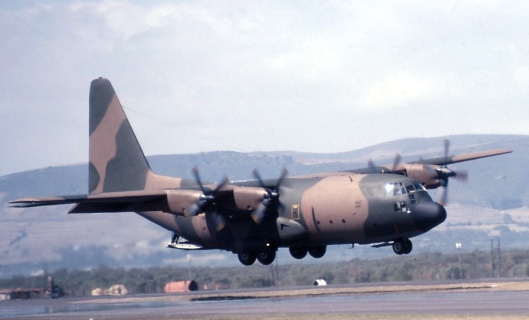 The cargo from the C-141 was quickly and efficiently transferred to the two C-130s and the latter took off into the night sky as stealthily as they had come, turning gracefully to the southwest where there was supposed to be nothing.
The cargo from the C-141 was quickly and efficiently transferred to the two C-130s and the latter took off into the night sky as stealthily as they had come, turning gracefully to the southwest where there was supposed to be nothing.
The men with the American accents returned to the vehicles and disppeared into the night. After the C-141 took off, all was quiet. For all intents and purposes nothing had happened in Darkest Africa that night. “If a tree falls in a forest and no one is around to hear it, does it make a sound?”
In reality, the two groups of white men were allies in a key but secret war involving around a dozen countries. Had the secrecy been maintained, 3000 Americans would not have died on 9/11 and the 1975 Unites States Congress would not today have their blood on its hands. But, history often turns on the smallest of events, just as the beat of a butterfly’s wings on the West Coast of Africa might lead to a hurricane that devastates New Orleans. And somehow, there is always a “do-gooder” to unwittingly ensure that evil triumphs. After all, the road to hell is paved with good intentions.
To understand the above event, we have to dial back the clock by 15 months to April 1974. We shall return to this event later when we have done this homework.
About Carnations, Communists and Ethnic Cleansing
In the wake of the April 1974 “Carnation” Communist Revolution in Portugal, the Portuguese authorities in Angola were siding with the Communist MPLA party in that country. Facing them was the FNLA based on the BaKongo tribe in the north, supported by US-allied Mobutu Sese Seko of Zaïre, where the CIA had its Africa operations headquarters.
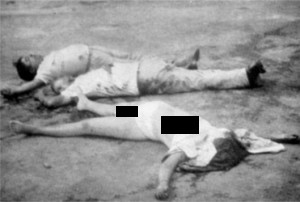 As far back as 1963, Bobby Kennedy had arranged help for the FNLA under Holden Roberto. The FNLA had a terrible reputation for the most inhuman slaughter of white Portuguese people (left) during its 1961 insurgency. Back then it was called the UPA, but it was led by Holden Roberto. That had not deterred the young Kennedy.
As far back as 1963, Bobby Kennedy had arranged help for the FNLA under Holden Roberto. The FNLA had a terrible reputation for the most inhuman slaughter of white Portuguese people (left) during its 1961 insurgency. Back then it was called the UPA, but it was led by Holden Roberto. That had not deterred the young Kennedy.
In June 1974 I was touring in Southern Angola with my parents-in-law-to-be. My prospective father-in-law, Bassie Basson, was a tough and difficult man who had been an ex-WWII Spitfire pilot in the South African Air Force. He had helped chase Rommel out of Africa and had then flown close ground support for the US, Canadian and other Allied forces in the terrible slog up the Italian peninsula, where he survived being downed by German anti-aircraft fire noth of Bertinoro.
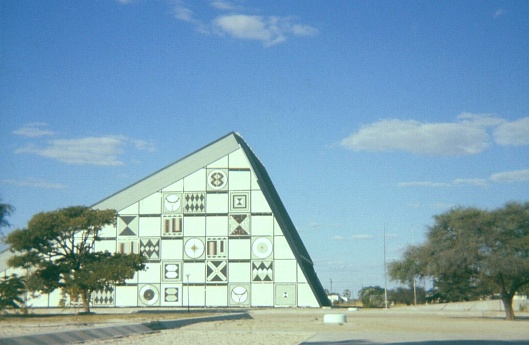 We travelled from Oshakati [click for map] in Namibia (above) into Angola to eventually make our way to Benguela and Lobito [click for map] via Sá da Bandeira (now renamed to Lubango). It was quite clear that Angola was collapsing. We had no idea of the intrigue that was playing out further north. We just heard all the Portuguese public radio transmissions on our car radio talking about three political groups. They were (1) the Communist MPLA under Augustino Neto, which the Portuguese and Soviets were trying to install as government, (2) Roberto’s FNLA in the north, and (3) UNITA under the charismatic Jonas Savimbi from the southern Ovimbundu tribe. With the Soviets backing the MPLA, and the CIA backing the FNLA, UNITA obtained some perfunctory help from Communist China.
We travelled from Oshakati [click for map] in Namibia (above) into Angola to eventually make our way to Benguela and Lobito [click for map] via Sá da Bandeira (now renamed to Lubango). It was quite clear that Angola was collapsing. We had no idea of the intrigue that was playing out further north. We just heard all the Portuguese public radio transmissions on our car radio talking about three political groups. They were (1) the Communist MPLA under Augustino Neto, which the Portuguese and Soviets were trying to install as government, (2) Roberto’s FNLA in the north, and (3) UNITA under the charismatic Jonas Savimbi from the southern Ovimbundu tribe. With the Soviets backing the MPLA, and the CIA backing the FNLA, UNITA obtained some perfunctory help from Communist China.
Even as we crossed the Cunene River at Fort Roçadas (below – The bridge was blown up later) on our 1974 holiday, the United States started funding Roberto’s murderous FNLA via the CIA offices in Kinshasa. By August 1974, the Soviets were flying arms into Angola for the MPLA and Romanian ships arrived with further equipment.
 Away from prying Western eyes, the Black Angolans were killing hunter-gatherer San Bushmen (below in Namibia) whenever they found them, because the latter had acted as trackers for the Portuguese Colonial forces. Some 25% of all the Angolan San, already near extinction as likely the world’s oldest ethnic group, were killed over this period. Though the term had not yet been invented, they were obviously the subject of Ethnic Cleansing.
Away from prying Western eyes, the Black Angolans were killing hunter-gatherer San Bushmen (below in Namibia) whenever they found them, because the latter had acted as trackers for the Portuguese Colonial forces. Some 25% of all the Angolan San, already near extinction as likely the world’s oldest ethnic group, were killed over this period. Though the term had not yet been invented, they were obviously the subject of Ethnic Cleansing.
By September 1974 the San sought refuge with the South African Army in Namibia to the south, who set them up with homes for themselves and their families at a secret base called Omega in the oddly shaped Caprivi Strip, near the famous Okavango Swamp of Botswana. From these very unique people the Army then created the tracker group known as Group Alpha. Their tracking skills are legendary. It would be there that I would personally meet them some 12 years later. Omega base is still there and may be seen on Google Maps. Given the Afrikaner penchant for irony, Group Alpha was based at Omega.
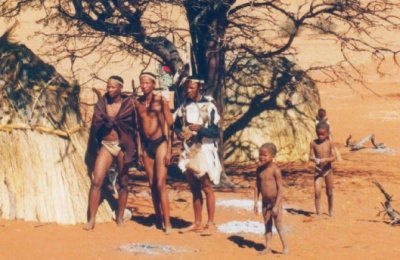
♣ Bear with this story about Cold War events and tribes in Africa. It will eventually take you as reader to 9/11 in New York via Washington and the Middle East. It will cover the terms of six US Presidents and return with a vengeance. The full story may be read in exquisite detail in AmaBhulu – the Birth and death of the Second America.
The Brezhnev Doctrine
Zaïre was, and still is in the 21st century, dependent on the Benguela railway line through Angola. As African tyrants go, ranging from benevolent dictators to cannibals and genocidal maniacs, the country’s leader Mobutu was one of the better ones, even though he was busy destroying the economy, stealing his country blind, and squirreling the money away in Switzerland. Situated to the east of Angola and south of Zaire, is Zambia, the former Northern Rhodesia. In 1974, it was ruled by Kenneth Kaunda. Kaunda was famous for whipping out a white handkerchief to dry his eyes as he emotionally addressed his people. The Red Chinese had helped him build a railroad to the Tanzanian Coast on the Indian Ocean, but it was never a totally reliable route. He eventually moved all these Chinese out of the country.
Both Kaunda and Mobutu knew that, if the Benguela railway line were cut, they would be totally dependent on South Africa for their mineral exports, central to their economies. Angola itself was inherently a very rich country, a major exporter of coffee, diamonds and a considerable amount of oil. The oil came from the non-contiguous enclave of Cabinda, situated to the north of the Congo River, beyond a narrow strip of Zaïre along that river. Here, the US company Gulf Oil had its operations.
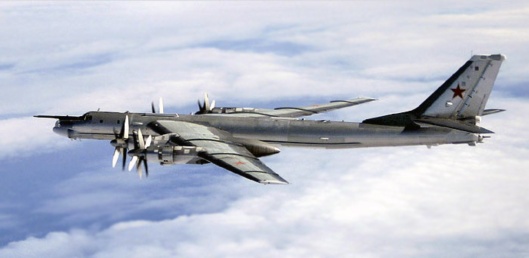
If the Soviets were to obtain any form of military foothold in Angola, it would immediately place the key Cape Sea Route within range of their massive long-range “Bear” (Tupolev Tu-95, above) reconnaissance aircraft. This would endanger the constant stream of oil supertankers headed for Western Shores past the Cape of Good Hope and my home town of Port Elizabeth. Mozambique had an equivalent location on the east coast of Africa, bordering directly on South Africa. The events of 1974 in Portugal and its two major African colonies of Angola and Mozambique were therefore of direct and immediate importance to greater Western interests.
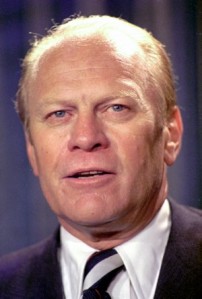 Naturally, the Soviets saw an opportunity in the United States’ vividly obvious reluctance to become embroiled in another Vietnam-like debacle at the time. The United States was also paralyzed by the so-called Watergate Scandal and these were the last days of Richard Nixon’s leadership. He resigned his office on 9 August 1974, and Jerry Ford (left) took over the role of President of the United States. While many Americans considered him a cipher, he was actually a man of great integrity and fundamental wisdom, as we shall soon see. As to why the Soviets had an interest in Africa, we need but consult Soviet Leader Brezhnev himself who announced in discussion with his ally, President Siad Barre of Somalia, that the Soviet aim was to,
Naturally, the Soviets saw an opportunity in the United States’ vividly obvious reluctance to become embroiled in another Vietnam-like debacle at the time. The United States was also paralyzed by the so-called Watergate Scandal and these were the last days of Richard Nixon’s leadership. He resigned his office on 9 August 1974, and Jerry Ford (left) took over the role of President of the United States. While many Americans considered him a cipher, he was actually a man of great integrity and fundamental wisdom, as we shall soon see. As to why the Soviets had an interest in Africa, we need but consult Soviet Leader Brezhnev himself who announced in discussion with his ally, President Siad Barre of Somalia, that the Soviet aim was to,
…gain control of the two great treasure houses on which the West depends: The energy treasure house of the Persian Gulf and minerals treasure house of Central and Southern Africa.
♣ Bear with this story about Cold War events in distant Africa. It will eventually clarify for any Americans with some powers of concentration just what effect their own internal political obsessions have in the greater world “out there”.
The 94th United States Congress
Back in Washington, the 94th Congress of the United States started meeting in the Capitol (below) in first week of January 1975. Both houses were controlled by the Democratic Party. Among them was a young senator from Iowa by the name of Dick Clark. For more about him, one may read THIS article. As the senator confesses, he “knew little about Africa”. That ignorance would show. At the White House, Henry Kissinger remained the Secretary of State. And he was very concerned indeed about developments in Angola and the attitudes of the new Congress.
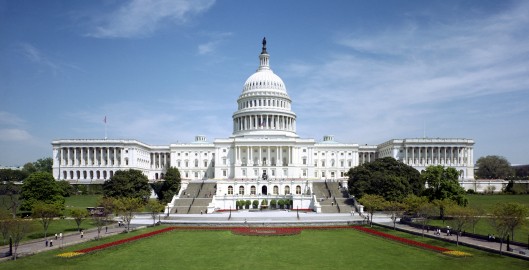
Various texts attempt rather desperately to blame Kissinger for the events to follow, but the Soviet records show that on 4 December 1974 President Marien Ngouabi of the (formerly French) Brazzaville Congo to the north of Zaïre approved a Soviet plan to airlift heavy weapons and ammunition to the MPLA via that country. According to John Stockwell, the CIA was authorized to pass $300,000 to Holden Roberto on January 22, 1975. This clearly followed the first moves made by the Soviets.
Realpolitik, African style
By the end of January 1975, the chessboard of Angola was laid out as follows:
| ♦ Holden Roberto’s FNLA was in the north, headquartered at Ambriz with his historical CIA support. He relied on support from Zaïre’s Mobutu where the CIA office ran the American support from Kinshasa.
♦ Savimbi’s UNITA was headquartered in the central south around Silva Porto, with nominal support from Kenneth Kaunda of Zambia. ♦ An FNLA subgroup, comprising Ovimbundu men under Daniel Chipenda, was located at Serpa Pinto, with a few hundred of his men in the far south in the bush at an old Portuguese Marines base called Mpupa. They had originally been MPLA, but had broken with that organization. Roberto did not quite trust them, because they were not BaKongo. They had no sponsor. ♦ The MPLA’s military wing, FAPLA, was firmly ensconced in the major western and northern towns and everywhere on the coast south of Luanda with Communist Portuguese and Soviet support. |
Between February and April 1975, Savimbi (UNITA), Roberto (FNLA) and Chipenda (without consutling his boss, Roberto) all approached South Africa with requests for help. Savimbi offered to turn on SWAPO, the United Nations’s pet group in Namibia. SWAPO was operating an insurgency against South African authority in the country and used Southern Angola as base. Roberto offered South Africa 50 miles deep “hot pursuit authority” over the Southern Angolan border. Chipenda went further and offered to shut the border to SWAPO and to assist South Africa in hunting down SWAPO units operating out of Southern Angola. He claimed he had offers of weapons assistance from the CIA. He also committed to work with UNITA. He wanted training for his men — welcome to Realpolitik, African style.
Around the same period, Prime Minister B.J. “John” Vorster of South Africa was approached by at least five Black African heads of state. They wanted South Africa to take direct military action in Angola to forestall a Communist victory and thereby prevent a major Soviet or Cuban presence in Sub-Saharan Africa. These men included the heavyweights Joseph Mobuto of Zaïre, Kenneth Kaunda of Zambia, as well as the two respected elder African statesmen, Felix Houphouet-Boigny of Côte d’Ivoire and Leopold Senghor of Senegal. Seretse Khama of Botswana was possibly another. Some sources claim further leaders were involved. This most likely included Omar Bongo of Gabon with whom South Africa had ongoing contact. It would seem US leaders did not comprehend this.
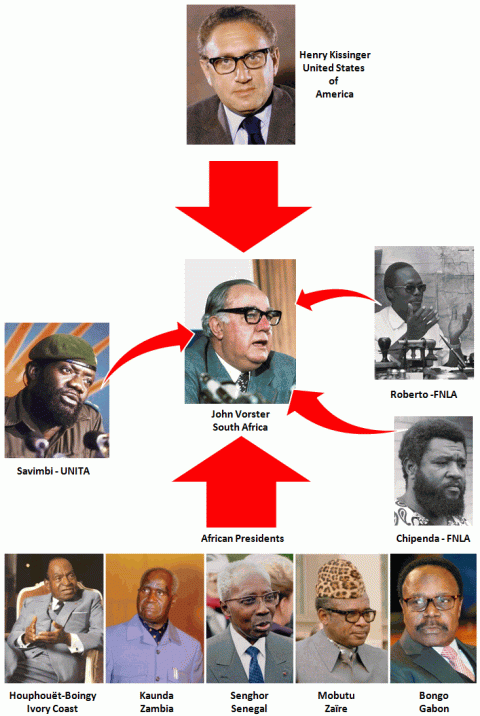 Here, finally, was a realistic and practical issue on which the Black African states were ready to set aside their very public differences with South Africa and make a pragmatic choice in the interest of the continent. Even Henry Kissinger would later write about his first experience of (and surprise at) the fact that South Africa’s apartheid policy was no insurmountable obstacle for many of Africa’s Black leaders in cooperating with the country on the greater problems of the continent. He would soon realise that his problem in respect of South Africa was in the USA, and not in Black Africa. Vorster had been building relationships with key African countries for some years. It would have been too much to expect someone like Dick Clark to know any of this. Given the attitude he subsequently revealed, he would not have listened anyway.
Here, finally, was a realistic and practical issue on which the Black African states were ready to set aside their very public differences with South Africa and make a pragmatic choice in the interest of the continent. Even Henry Kissinger would later write about his first experience of (and surprise at) the fact that South Africa’s apartheid policy was no insurmountable obstacle for many of Africa’s Black leaders in cooperating with the country on the greater problems of the continent. He would soon realise that his problem in respect of South Africa was in the USA, and not in Black Africa. Vorster had been building relationships with key African countries for some years. It would have been too much to expect someone like Dick Clark to know any of this. Given the attitude he subsequently revealed, he would not have listened anyway.
None of these African countries trusted the Soviets or Cubans on their borders, but, if the West was to appear weak in the face of the Soviet challenge, they would have to cut their cloth to suit the wind. It is worth repeating, “Welcome to Realpolitik, African style.” Such was the life of a weaker country in the Cold War. It had to choose a side and suffer the consequences. South Africa was a natural, cultural, and historic part of the West and never saw itself as having a choice.
Enter South africa and the United States.
On 14 July 1975, with Communist Cuban advisors on the ground in Angola and Soviet weapons being supplied at a considerable rate, John Vorster of South Africa decided to support the FNLA and UNITA to oppose the Soviet-Cuban-MPLA Axis. A South African Bureau of State Security (BOSS) memorandum states that Vorster did so under American pressure. Henry Kissinger confirms President Ford approved the United States action in Angola in the very same week. Two weeks later the C-141 in the opening section took off from Charleston. The timing was clearly not coincidental, but the co-operation was secret in the extreme and has been the subject of much twisted debate since then.
In his work, based on access to South African diplomatic communications from the office of the South African ambassador in Washington in early 1976, Odd Arne Westad of the London School of Economics and Political Science concludes that South Africa was expecting international political support from the United States for helping the superpower in the matter of Angola. In a later 1998 interview with Left Wing historian Piero Gleisejes, the head of the CIA station in Luanda, Robert Hultslander stated, with reference to the developments in Angola, that he had been unaware at the time that the United States would…
…eventually beg South Africa to directly intervene to pull its chestnuts out of the fire.
The 94th Congress of the United States chose this crucial moment to inject itself into the international security role of the United States with no understanding of the realities on the ground. Even worse, it treated the CIA as an enemy of its own state. It somehow blamed the CIA for events in Vietnam and elected to point no finger at the assasinated John F. Kennedy who was the man who had escalated the Vietnam effort into a fully-fledged war. Obssessed with “keeping the CIA from ever again getting the US into a ‘war we cannot win'”, the congressional intent was to clip the CIA’s wings by whatever means possible.
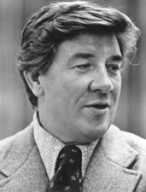 Starting 4 August 1975, Senator Dick Clark (left), the Chairman of the Africa Subcommittee of the Senate Foreign Relations Committee, started touring Zaire and Angola in order to determine whether the US was involved in the conflict and whether the CIA was “illegally collaborating with South Africa“. The obsession of the Left in the US with South Africa had clearly already transcended the pragmatic dealings of Black Africa with South Africa. His Republican colleagues started referring to him as “The Senator from Africa”.
Starting 4 August 1975, Senator Dick Clark (left), the Chairman of the Africa Subcommittee of the Senate Foreign Relations Committee, started touring Zaire and Angola in order to determine whether the US was involved in the conflict and whether the CIA was “illegally collaborating with South Africa“. The obsession of the Left in the US with South Africa had clearly already transcended the pragmatic dealings of Black Africa with South Africa. His Republican colleagues started referring to him as “The Senator from Africa”.
It never ceases to amaze how it is acceptable for liberals like Clark that colleagues or allies should cooperate with the real monsters on Earth, but the mere mention of South Africa drives them to “belch bile” and cast all reason to the wind. As THIS article points out, he focused on challenging “Cold War policies that he believed hurt the larger struggle against apartheid that Mandela symbolized“. This means he viewed the U.S.S.R. with all its ICBMs and nuclear weapons as a smaller threat to the United States than South Africa’s internal policies. All this at the height of the Cold War. This blinkered liberal obsession would eventually cost 3000 innocent American lives.
Four weeks later, on 30 August 1975, commandant Jan Breytenbach of the South African Defence Force (SADF) flew into the FNLA base at Mpupo to meet with Chipenda’s local officer in command. He was shocked at the pathetic state of these starved “troops”, which he describes in his own book. To his amazement, when he got back to Namibia he was issued with arms for these three hundred men and was instructed to train them. Jan was the equivalent of a US Navy SEAL. A few weeks later, on 24 September, a SADF C-130 Hercules landed at Silva Porto with personnel to train 1,000 UNITA men. The CIA was in attendance.
If a tree falls in a forest: Part 2
The Americans on the tarmac at N’Djili on 29 October 1975 in the opening section above were CIA men. The men from the C-130s were South Africans of the country’s Bureau of State Security (BOSS). The cargo was US-arranged weapons and other supplies on the way to UNITA men being trained by the South Africans at US request at Silva Porto in Angola. The town has since been renamed to Kuito. CIA men were on the ground with the South Africans in Angola.
These two groups got along like a house on fire. That is to be expected from nations with the same blood lines and remarkably similar histories. The ancestors of both spoke Dutch in the early 1700s, the South Africans at the Cape of Good Hope and the Americans in upstate New York. Their more recent ancestors spoke English. Both groups had Judeo-Christian values and both believed in Democracy within their own cultures. Their fathers had fought together in WW1, WW2 and Korea. In their values and views on life the South Africans were closer to Americans than the British were. Both nations had twice fought the British in their earlier histories. The numerically superior Americans had won with French help, the haplessly outnumbered South Africans had lost, having had nothing but token support. South Africa had finally gained its independence from Colonial Britain a mere fourteen years before, in 1961.
CIA man John Stockwell would later write,
Especially in the field, CIA officers liked the South Africans, who tended to be bluff, aggressive men without guile. They admired South African efficiency.
To see and hear Stockwell address some of the above interaction live, click HERE. In this video clip he states,
BOSS was considered to be a friendly service.[…] The CIA did not run any operations there [South Africa], because it might offend BOSS.
Many Americans would later ask how their country developed such an unflattering reputation in the developing world. The answer can be traced back to the following 6 months in Angola. So, stay with me here.
The Fruit Truck War
At midnight on 15 October 1975, a very strange little army crossed the border from Namibia into Angola at Cuangar. As the men rolled through Cuangar, the Portuguese refugees gathered at this remote town lined the road for 2 miles cheering them on. Task Force Zulu, as it was called, comprised Alpha Group, the ex-Angolan San Bushman unit, and Bravo Group, Daniel Chipenda’s Angolan FNLA from Mpupa base. Both operated under South African officers. They were equipped with Soviet weapons and their vehicles were now a collection of fruit and furniture trucks that had been used by white Portuguese refugees to escape Angola.
The first clash of this unit with the real enemy, the army of the MPLA known as FAPLA, occurred on 19 October. On 20 October, two troops of Eland armored cars (see further below) caught up with Zulu and dramatically strengthened the task force. On 23 October, Task Force Zulu took Sá da Bandeira. This was where I had visited just over a year before with my prospective parents-in-law.
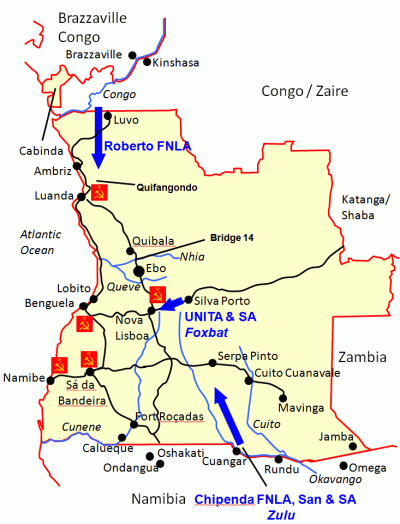 By 13 November, after 33 days of fast moving fighting, Task Force Zulu had pushed back the FAPLA/Cuban forces 600 miles and they had taken and entered the biggest harbor in Angola, Lobito, to a shower of flowers. Stockwell, with his military training and background in Vietnam, refers to Task Force Zulu as “exploding” through the MPLA/Cuban ranks in a “blitzkrieg,” which in November 1975 “almost won the war.” He considered Task Force Zulu the most effective military strike force ever seen in Black Africa. They had cleared the FAPLA-Cuban forces to within 100 miles of the capital of Luanda. By now they had met up with Battlegroup Foxbat, in effect the South African trained UNITA Army from Silva Porto, the men who had received the help from the US C-141 cargo flights and the CIA.
By 13 November, after 33 days of fast moving fighting, Task Force Zulu had pushed back the FAPLA/Cuban forces 600 miles and they had taken and entered the biggest harbor in Angola, Lobito, to a shower of flowers. Stockwell, with his military training and background in Vietnam, refers to Task Force Zulu as “exploding” through the MPLA/Cuban ranks in a “blitzkrieg,” which in November 1975 “almost won the war.” He considered Task Force Zulu the most effective military strike force ever seen in Black Africa. They had cleared the FAPLA-Cuban forces to within 100 miles of the capital of Luanda. By now they had met up with Battlegroup Foxbat, in effect the South African trained UNITA Army from Silva Porto, the men who had received the help from the US C-141 cargo flights and the CIA.
The next act in the war was about to unfold in the north of the country, while efforts were afoot in the United States to destroy the position of the West in the entire venture. Thinking Americans would do well to question why individuals within their community would seek the destruction of American effort with such dedication.
Escalation
In the Organization for African Unity, the OAU (the “African United Nations”) the support was split between the US Allies and the Soviet-Cuban-MPLA Axis. If the last assault by the FNLA and UNITA on Luanda could be successful, the OAU would swing in their favor. However, this required commitment from the West, ostensibly led by the United States. Also, much of the success depended on the ever-present support of the South Africans.
On the other hand, if the assault folded, or if the Soviet Bloc shipped in major amounts of support, the OAU would immediately shift its support to the Soviet axis and then the classic Communist rhetoric about “Colonialists,” “Imperialists,” and “Racists” would be heard again all over Africa. It would also be obligingly and obediently echoed in the US and British media. It would matter not one iota that South Africa was in Angola at the request of several senior African heads of state. That would be comfortably forgotten and no liberal would mention it. It would matter not one iota that the “Racist Invaders” were in fact largely trained Angolan black men and Angolan San soldiers. This would be conveniently ignored. Such are the vagaries of Africa and the left-leaning media of the West. And back in 1975 the rank and file American had not yet learnt to distrust the American media. They still thought “all reporters were Woodward and Bernstein”.
Fidel Castro (below) in Havana and John Vorster in Pretoria both knew they now faced a major escalation in the war. In Washington, the CIA was struggling to maintain the veil of secrecy over its efforts. The Soviets maintained their air bridge and there were between 140 and 400 Soviet “advisers” with the MPLA. Two staggering blows were about to fall in rapid succession.
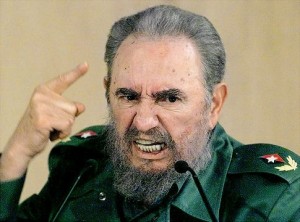
On 11 November 1975, the Cubans totally defeated Holden Roberto’s FNLA “army” and its Zaïrian allies at a place called Quifangondo. Roberto had ignored every piece of advice offered by the South Africans and the CIA, who had to watch helplessly as the joint force was annihilated. What remained of the FNLA and Zairean troops pillaged the country all the way back to Zaire and the FNLA ceased to be a fighting force.
Meanwhile, the Zulu and Foxbat Groups with their white South African officers and their Black Angolan and San soldiers, supported by the South African-manned Eland armored cars, kept advancing at speed from the south. However, they were now encountering rocket-armed Soviet helicopters, T-34 tanks, and long range cannon with better accuracy than the 122 mm “fire and pray” Stalin Organs. It was turning into a regular conventional war.
And then, in Washington
It was clear that Fidel Castro was shipping large numbers of troops and equipment into Angola, having made that decision around 5 November 1975. Furthermore, the Soviet weapons supply to the MPLA was literally ten times as large as that of the United States to the FNLA and UNITA. To stabilize the situation and secure a victory, the United States would have to step up to the plate. Meanwhile the CIA was floating proposals to mine the harbor of Luanda and use US submarines to prevent the Soviet arms shipments and Cuban troop disembarkation. It would later turn out that the South African Minister of Defense, PW Botha, was relying on this help from Henry Kissinger. He thought the United States could be relied upon when “the chips were down”. This author was told about a decade later by a SADF officer that the French had warned the South African military not to trust the Americans under any circumstances.
The second blow for the Allies fell on 22 November 1975. Many thousands of miles away in Washington all hell broke loose when British journalist Fred Bridgland’s article about South African soldiers in the company of CIA operatives at UNITA’s Silva Porto base appeared in the Washington Post. The simple perfunctory dispatch of his article from “Darkest Africa” was the “beat of the butterfly’s wing” that would initiate a “hurricane to devastate New Orleans”. Of such small moments history is made. Those who want more insight in to Fred Bridgland the man can read his later 1981 article about Savimbi HERE. In his view, Savimbi “bore the mark of Cain” because he had the help of South Africa. This perception had more to do with his own British prejudices than the realities on the ground, as already explained above. Bridgland has made a career from his 1975 article.
In the very far north of Angola, a tiny handful of South African Army personnel had been working closely with the CIA in supporting the FNLA up to the disaster at Quifangondo. They had been promised by the CIA that the agency would provide them with a way home by air if the FNLA failed. When these men arrived at the CIA extraction point, the Americans had simply flown off, leaving them to their fate thousands of miles from home. The United States had literally deserted its allies on the field of battle in the face of the enemy. It is difficult to conceive of a greater treason among men.
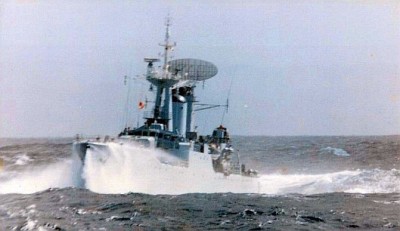
In a daring mission on 27 November 1975, a South African Navy frigate, the SAS President Kruger (left), extracted the knot of men from a beach near the northern Angolan village of Ambrizete in hostile waters now completely controlled by the Soviet Navy.
Ford and Kissinger do their part
The Ford Administration fought back politically and diplomatically. On 8 December 1975, the United States Ambassador to the United Nations, Daniel Patrick Moynihan declared from the rostrum that if only South Africa, and not the also the Soviet Union, were condemned, then the UN General Assembly would be on record as having found that invasion of African countries by some white armies [meaning the Soviets and Cubans] was perfectly acceptable. He failed to point out that the South African effort was backed by several leading Black African countries, while Task Force Zulu was mostly black Angolans under a small core of South African leadership, together with a few white soldiers in armored cars.
The OAU was still openly divided and watching carefully for a winner. Two days after Moynihan’s statement, the African countries withdrew their proposed resolution to condemn only South Africa. By mid-December only 14 of the 46 member countries of the OAU had recognized the Soviet-backed MPLA government of the newly independent country. That represented much less than a third of the membership. The West could still win this thing. Clearly, the destruction of the FNLA at Quifangondo had been a far from fatal blow to the Allied effort. In the south the UNITA-Chipenda-San-South African forces were still moving northward apace. Everything now depended on the United States exhibiting resolve in the face of a Soviet challenge.
 Against this background President Ford, a man of integrity and character, called Soviet ambassador Dobrynin (left) to the Oval Office on 9 December. In the presence of Henry Kissinger, the president stated to Dobrynin that US-Soviet relations would be severely affected by the Soviet adventure so far from home. The next day, 10 December 1975, the Soviet arms shipments stopped. This termination is also confirmed by Porter in his study of this conflict.
Against this background President Ford, a man of integrity and character, called Soviet ambassador Dobrynin (left) to the Oval Office on 9 December. In the presence of Henry Kissinger, the president stated to Dobrynin that US-Soviet relations would be severely affected by the Soviet adventure so far from home. The next day, 10 December 1975, the Soviet arms shipments stopped. This termination is also confirmed by Porter in his study of this conflict.
Over the same period, Kissinger met with Giscard d’Estaing, president of France, who undertook to move Mirage fighter jets (below) to Zaïre and supply helicopters armed with missiles for use in Angola. He would also send auxiliary troops of Moroccan or French-African extraction. All depended on the US committing properly.
Kissinger was worried by developments in the United States Senate. Enraged by what he would later call a “McGovernite Congress,” he warned his staff that he was concerned about…
…the African reaction when they see the Soviets pull it off and we don’t do anything. If the Europeans then say to themselves, ‘If they can’t hold Luanda, how can they defend Europe?’ The Chinese will say we’re a country that was run out of Indochina for 50,000 men and is now being run out of Angola for less than $50 million.
He had already reported Mao’s view of the United States to President Ford earlier on October 25, 1975:
We are the ‘swallow before the storm’. We are ineffectual. What we say is not reliable.
Kissinger, the statesman that he is, realized the realties of the situation. All hinged on the United States being up to the challenge. The Soviets were exploiting the reverse in Vietnam and the fall of Nixon.
The bleeding simply HAD TO be stopped.
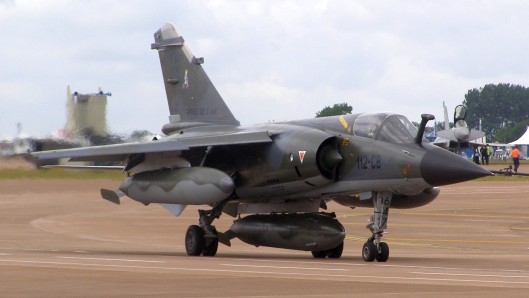
Painful Setbacks and Striking Successes
In the south central region of Angola, the Allied advance still moved inexorably northward. Battlegroup Foxbat had been badly cut up in a Cuban ambush at a place named Ebo and a number of FNLA soldiers had been killed. The Cubans then systematically killed the wounded Black Allied soldiers. Commandant George Kruys, now the leader of Foxbat, would have his revenge.
Matters came to a head at what came to be called the Battle of Bridge 14; a clash that so profoundly worried Fidel Castro that he even relocated it on the map in an attempt to hide the truth from his people. The Cubans threw everything they had into the battle at a river crossing, but they failed in their defensive efforts. Independent parties reported that several hundred Cubans were killed. Matters became surreal when they fled.
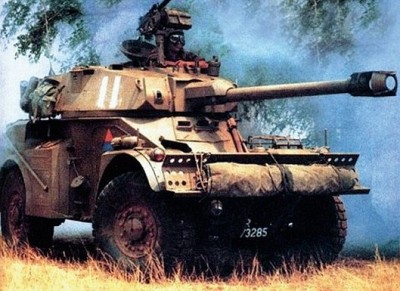
In one documented case, a Soviet truck with twenty Cubans rushed back toward Luanda from the battle and indicated to an armored car also headed north that it wanted to overtake. The armored car allowed them to do so and then put a 90mm round into the back of the truck killing all on board – it was a South African Eland armored car (left) that was already ahead of the fleeing Cubans and headed for the capital, Luanda. The BBC reported truckloads of dead on the road to the north. Among the dead was the leader of the Cuban Expeditionary Force, Commandant Raul Diaz Arguelles. The road to Luanda lay essentially open, only the town of Quibala remaining to be taken.
Before Kruys could advance again and retain Angola for the West, events in the United States Congress would overtake the war.
Materiel, Money and Commitment – Testing the West
This is a good point at which to summarise the situation:
The Soviets and their Cuban surrogates had exploited the Carnation Revolution in Portugal to grab Angola out of the Western fold. They had shipped massive amounts of arms as well as men into Angola. Several Black African countries had pleaded with South Africa to intervene to stop the Soviets. Moreover, the United States had asked South Africa to lead the effort. Yet US men had deserted their friends in the face of the enemy and stranded their South African allies. Those allies had nevertheless successfully driven the Soviet surrogate forces back to within miles of the capital Luanda. All they now needed was some financial and weapons support to retain one of the key countries of Africa for the West and to deny the Soviets a foothold in Africa. This would prevent the U.S.S.R from threatening US oil and mineral supplies.
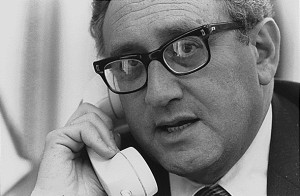 South Africa could not conceivably keep a war going alone against the mighty Soviet Union, especially given that it was under weapons embargo from the very United States it was assisting. South Africa had already spent $133M on this war, four times what the US had spent. The CIA offices in Kinshasa and Pretoria CIA were clamoring for support for the South African forces. Proposals were eventually made to CIA head office for providing weapons directly to the South Africans and Kissinger (above) was using all his powers of persuasion with John Vorster to keep South African forces in the field. Yet his own US government was vacillating on the subject, and Clark was threatening his efforts.
South Africa could not conceivably keep a war going alone against the mighty Soviet Union, especially given that it was under weapons embargo from the very United States it was assisting. South Africa had already spent $133M on this war, four times what the US had spent. The CIA offices in Kinshasa and Pretoria CIA were clamoring for support for the South African forces. Proposals were eventually made to CIA head office for providing weapons directly to the South Africans and Kissinger (above) was using all his powers of persuasion with John Vorster to keep South African forces in the field. Yet his own US government was vacillating on the subject, and Clark was threatening his efforts.
Savimbi had flown to Pretoria on 10 November to beg John Vorster to keep the South African forces in the field beyond the Angolan Independence date so as to clear the Benguela railway line. He obviously felt that such a step would keep Kenneth Kaunda of Zambia “on-side.” He asked that the troops should remain until the OAU could meet to decide which side they would support in the war. Anything was still possible. Vorster acceded to these requests, but the OAU meeting was delayed.
All now depended on the resolve of the United States
The United States is the Problem
Meanwhile, the revelations about Angola in the media precipitated a closed debate on the Defense Appropriations Bill in the U.S. Senate Appropriations Committee around 15-16 December 1975. During the debate, Henry Kissinger’s Department of State provided a briefing document that contained two central truths that would be wiped aside in the debate:
“Another factor we had to weigh was the effect of a Marxist-oriented Angola on future developments in Southern Africa. Our conclusion was that it would increase the prospects for violent rather than peaceful change and perhaps fatally undermine the incipient trend toward détente between South Africa and Black African States. […]
…there is African sentiment; admittedly only in private but probably more extensive than we know, which accepts the necessity of South Africa’s balancing intervention if a Soviet victory is to be prevented and the military balance necessary to achieve political compromise is to be maintained.”
This was a huge understatement, and Kissinger knew it very well. One day later, on 17 December, he met in Paris with Mandungu Bula Nyati, State Commissioner for Foreign Affairs and International Cooperation of Zaire, who told him:
We will be Machiavellian. Let the South Africans use their forces and we will then use this to get the Africans to get the Russians out. That’s my opinion. Talk will not settle anything. The Russians won’t leave. We’ll continue to attack South Africa and we will condemn the Soviet Union too. Let the South Africans know that we will be attacking them as well as the Russians. We will be comparing the Soviets to Hitler in 1939. Let the South Africans know that this is just our way of showing up the Russians… […] …We are convinced the Soviet Union is trying to destroy us.
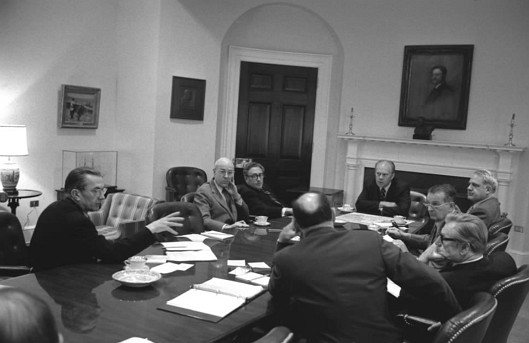
Back in Washington, on the 19th of December, it was painfully obvious to the security attendees at a meeting with Henry Kissinger that they needed South African help as regards training and leadership of the pro-Western effort. However, their own domestic political arena could not process that. The released (but sanitized) minutes of that meeting make deeply fascinating reading, but they are best summarized by the meeting notes made by Robert S. Ingersoll, Deputy Secretary of State. The image above shows CIA director William Colby speaking during a National Security Council meeting earlier in 1975. The experienced Ingersoll is seated on the left between Colby and Kissinger.
Ingersoll noted,
The key to keeping our side in Angola from collapsing is So. Africa. As far as Africans are concerned they would agree to have So. Africa clean up Angola, but we couldn’t pay the domestic price in this country.
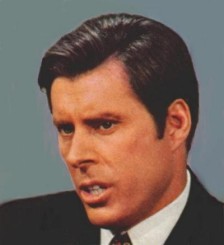 Ingersoll was proven correct. The problem lay not with racial matters in Africa. It lay distinctly with racial matters within the United States. Despite these central points explained above, John Tunney (left), the young liberal anti-Vietnam War Democrat from California, was instrumental in having the $28 million earmarked for any anti-Soviet faction in Angola removed from the Appropriation Bill. This would become known as the Tunney Amendment. Therewith ended the Ford Administration’s efforts in Angola. The House of Representatives would eventually vote 323 versus 99 for the Tunney Amendment on 27 January 1976. And therewith the United States faced away from the world and withdrew in upon itself to enter one of the lowest periods in its existence as a nation. And the Republican members cannot wash their hands, given their obvious support for the Amendment.
Ingersoll was proven correct. The problem lay not with racial matters in Africa. It lay distinctly with racial matters within the United States. Despite these central points explained above, John Tunney (left), the young liberal anti-Vietnam War Democrat from California, was instrumental in having the $28 million earmarked for any anti-Soviet faction in Angola removed from the Appropriation Bill. This would become known as the Tunney Amendment. Therewith ended the Ford Administration’s efforts in Angola. The House of Representatives would eventually vote 323 versus 99 for the Tunney Amendment on 27 January 1976. And therewith the United States faced away from the world and withdrew in upon itself to enter one of the lowest periods in its existence as a nation. And the Republican members cannot wash their hands, given their obvious support for the Amendment.
In Washington, dismayed by the actions of Congress, President Ford addressed the press and spoke the prophetic words:
The Senate decision to cut off additional funds for Angola is a deep tragedy for all countries whose security depends upon the United States. Ultimately, it will profoundly affect the security of our country as well. How can the United States, the greatest power in the world, take the position that the Soviet Union can operate with impunity many thousands of miles away with Cuban troops and massive amounts of military equipment, while we refuse any assistance to the majority of the local people who ask only for military equipment to defend themselves?
The issue in Angola is not, never has been, and never will be a question of the use of U.S. forces. The sole issue is the provision of modest amounts of assistance to oppose military intervention by two extra-continental powers, namely the Soviet Union and Cuba. This abdication of responsibility by a majority of the Senate will have the gravest consequences for the long-term position of the United States and for international order in general.
A great nation cannot escape its responsibilities. Responsibilities abandoned today will return as more acute crises tomorrow.
The last sentence above would come to haunt the informed in the United States on September 11, 2001. President Ford was a wise man of integrity who was wrongly regarded as a cipher in the United States. His country now turned away from the International Communist Revolution and focused inward.
Twenty six years later his prophesied “acute crisis” would come flying out of a beautiful blue September sky and change the United States forever. And 3000 innocent Americans would die. The men who made the decision on the Tunney amendment may well look into the mirror at this point and wonder about themselves.
The United States Capitulates in Africa
The Soviets and Cubans now correctly assessed the new American position as one of capitulation in the Third World and promptly resumed their arms supplies and troop shipments at an escalated rate on 24 December 1975. Secretary of State Kissinger makes the vividly clear strategic conclusion in his own book that, for the first time in the Cold War, the United States had capitulated to a Soviet-sponsored military adventure.
As late as January 1976, there was still some limited hope for the West. At the 12 January 1976 meeting of the OAU the delegates were still split straight down the middle at 22 versus 22. The map below shows the OAU member states at the time in brown. The Soviets failed to get the organization to condemn South Africa.
Then Nigeria came out in support of the MPLA. It has been suggested that the Soviets paid off the Nigerian delegation, a country that is known worldwide in the 21st century for its endemic corruption. The term “Nigerian Scam” is also well established and identified within the US State Department, generally known as a “419” scam, named after the relevant section of the Nigerian Criminal Code.
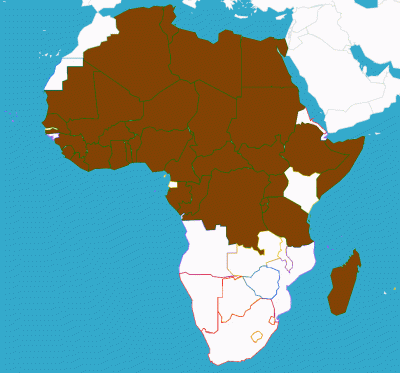
Finally, on 11 February 1976, the bulk of the African states fell in line behind powerful Nigeria, including some that had asked South Africa to intervene in the first place; such is Africa. Nevertheless, the vote was very far from unanimous, being only 27 to 19 in favor of recognizing the MPLA government in Luanda. Clearly, no fewer than 19 other Black African countries still had few qualms about the South African help to the opposing parties. But they had now been deserted by the United States and had to keep quiet. The Soviet ambassadors in their various capitals, however, were doing their jobs and pressuring their hosts and pointing at the American volte face. The result was entirely inevitable.
On 23 February 1976, the OAU passed a resolution condemning South Africa while completely ignoring the influx of Cuban troops and the Soviet weapons buildup. It brazenly ignored the fact that its own leading members had sought the help from South Africa in the first place. It stated that the new “People’s Republic of Angola” was,
…a victim of an intolerable aggression by the troops of the racist and fascist Government of South Africa who are occupying part of its national territory.

We were now “racists” and “fascists” again, even as young white South Africans were dying helping their black fellow Africans to keep the Soviet bear out of Africa. And that Soviet Bear was in Africa only because of America. Stockwell explains that the South African government realized that the United States was going to withdraw and therefore “gave up in disgust and returned across the border as efficiently and quietly” as they had originally entered Angola.
“Disgust” was an understatement. In Parliament on 17 April 1978, the South African Minister of Defence, P.W. Botha (above), commented,
…we were ruthlessly left in the lurch.
Shortly before his death on 31 October 2006 Botha granted a final interview in which he emphatically stated that Henry Kissinger flew to Pretoria to speak to him after these events and that he told Kissinger:
Don’t hide behind your Congress. You know you left us in the lurch.
Bitterness in Pretoria and Washington
The entire 1975/6 Angolan experience left great bitterness against the United States within the South African Defense community, and would color all future relations with the United States down to the avoidance of even the most insignificant American-made parts in South African military equipment design. Ironically, the United States would later have to purchase these designs for its 21st century war in Iraq in order to supply its troops with anti-IED equipment.
The cooperation between the United States and South Africa would continue at arm’s length in matters of intelligence, but the trust would never be restored. The reader is referred to Chapter 20 (The Korean War) and to Chapter 19 (Second World War) of the book AmaBhulu in order to comprehend the disgust and dismay.
PW Botha, South African Minister of Defense at the time, told parliament that the intervention by South Africa had been “part of the involvement of the free world,” but that South Africa was “not prepared to fight on behalf of the free world alone.” It would now defend “its own borders and those that it was responsible for.”
Kissinger’s frustrated statement to President Ford (“We are the ‘swallow before the storm’. We are ineffectual. What we say is not reliable.”) had been proved correct. Decades later Kissinger’s dismay at the conduct of Senator Clark in particular was still vividly evident. He insists Clark had been kept informed all along but, when the moment to be counted came, Clark denied being consulted.
The joint effort in Angola had potentially been a grand example of white and black working together in defense of Africa against overseas intruders. It could have set a positive tone for the next two decades. Unfortunately, liberal white men in North America had somehow found it incomprehensible that white and black in Africa could genuinely cooperate in resisting Soviet designs in Africa. They preferred to be cowed by their own self-made failure in Vietnam, brought about by their own Democratic Party presidents. They preferred to be swayed by their own unique historic race relations demons exemplified by the image below. The ordinary outnumbered white South African had no comprehension of this uniquely American background that wrongly colored all the dealings of the United States with South Africa.
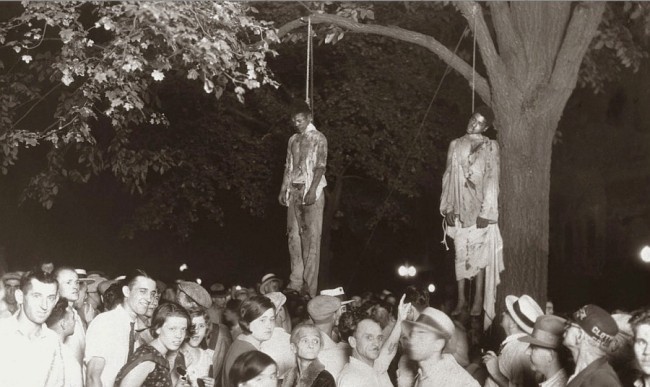
In May of 1976, according to Brand Fourie (below) who led the Foreign Service for South Africa, Henry Kissinger advised Prime Minister Vorster that South Africa could not rely on American assistance if the Soviets organized a military assault on the country. South Africa now knew where it stood after having fought alongside the United States in three major wars, WWI, WWII and Korea. We were completely alone on earth, sold out by our own blood.
On 29 June 1976, President Ford signed into law the infamous Clark Amendment that forbade any military support for parties in Angola. On 22 November 1976, the “People’s Republic of Angola” was recognized as the 146th member of the United Nations. It assumed its proscribed role on the shelf as Soviet Client State and springboard for World Communist Revolution.
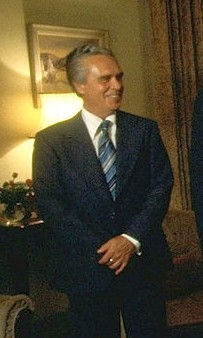 As though to demonstrate just how ineffectual the United States had become against the Soviets under the post-Vietnam Democratic Congress, the Ford administration was reduced to making its displeasure known by calling off an exhibition baseball series between the United States and Cuba. Kissinger experienced the effects of the US failure in Angola when the Brazilian Foreign Minister Antonio da Silveira told him to his face that Brazil was no longer sure that it could rely on the United States. Back in Angola a senior Cuban Intelligence officer took over the apartment that the CIA station chief, Robert Hultslander, had occupied in Luanda. With the Cubans now settled in Africa, the wait for the next Soviet-Cuban move on the international chessboard would be very short indeed. The virus had taken and Angola was Ground Zero. America had willfully failed.
As though to demonstrate just how ineffectual the United States had become against the Soviets under the post-Vietnam Democratic Congress, the Ford administration was reduced to making its displeasure known by calling off an exhibition baseball series between the United States and Cuba. Kissinger experienced the effects of the US failure in Angola when the Brazilian Foreign Minister Antonio da Silveira told him to his face that Brazil was no longer sure that it could rely on the United States. Back in Angola a senior Cuban Intelligence officer took over the apartment that the CIA station chief, Robert Hultslander, had occupied in Luanda. With the Cubans now settled in Africa, the wait for the next Soviet-Cuban move on the international chessboard would be very short indeed. The virus had taken and Angola was Ground Zero. America had willfully failed.
Interlude: Black Africa votes with its feet
As the Bravo group moved back to Namibia, the Angolan soldiers of the group were left with instructions to report for service at posts in Angola near the Namibian border in January 1976, including at the original Mpupa inside Angola. When Jan Breytenbach arrived back at Mpupa in Southern Angola in January 1976, he found, not 300, but several thousand ex-FNLA Angolan black men with their families waiting for him. Here was Black Africa voting with its feet. These men trusted the supposedly “racist” white leadership core. They would become known as 32 Battalion; “Buffalo”; Os Terriveis—The Terrible Ones—a sobering example of camaraderie between black men and white men of Africa in fighting the Communists who had flown thousands of miles from other continents to inflict their flawed political model on the African continent. In future, the mere mention of Buffalo’s involvement in an attack would cause opposing Angolan FAPLA troops to throw away all their equipment in panic and flee, as reported by none other than Soviet advisers in Angola.
The uninformed reader may want to view THIS video for some insight into the relationship beyond life and death among these white and black men of Buffalo.
Consequences
There is no way a superpower can fail as comprehensively and visibly as the United States in Angola and there NOT be severe consequences. Savimbi withdrew with his UNITA army to the far southeastern Cuando-Cubango region of Angola adjoining Zambia and Namibia. From here he would continue to bleed the MPLA for 27 years with help from Zaire, Zambia and South Africa. The Soviets and Cubans largely left South Africa alone in Namibia for the rest of the 1970s.
In the United States in 1976, a new president was elected in the form of the Georgia Governor and peanut farmer, Jimmy Carter. Therewith the United States entered its weakest international condition since World War II. His Ambassador to the UN, Andrew Young, thought it wise to suggest that
There is a sense in which the Cubans bring a certain stability and order to Angola.
Young would eventually be fired for secretly meeting with the Palestine Liberation Organization.
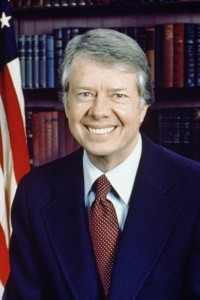 Carter was tested within one year when the Cubans and Soviets quite predictably backed an invasion of Zaire from Angola starting 7 March 1977. Perhaps Young thought that would bring “stability” to Zaire as well. France elected to act and drove the invaders back. The only help from the United States was so-called “non-lethal aid” to the Western countries involved. The exact same African countries who had sought South Africa’s aid two years earlier backed the French this time.
Carter was tested within one year when the Cubans and Soviets quite predictably backed an invasion of Zaire from Angola starting 7 March 1977. Perhaps Young thought that would bring “stability” to Zaire as well. France elected to act and drove the invaders back. The only help from the United States was so-called “non-lethal aid” to the Western countries involved. The exact same African countries who had sought South Africa’s aid two years earlier backed the French this time.
Having twice tested the United States and found it woefully wanting, the next Soviet-Cuban move was in the Horn of Africa. The emperor Haile Selassie of Ethiopia had been deposed in Ethiopia and replaced by a homicidal maniac called Mengistu Haile Mariam who subsequently walked into a cabinet meeting and shot all the ministers. This was a man after the Soviets’ hearts. Sounding just like the liberal Western media, the Soviets actually tried to link the territorial dispute between Ethiopia and Somalia over the Ogaden region to apartheid in South Africa, thousands of miles away. They claimed the West had instigated a war there in order to divert attention from South Africa’s racial policies. The Soviets backed Ethiopia and provided equipment, logistics and body bags, while the Cubans did the dying. Sixteen thousand Cubans troops moved in and drove out the US-backed Somalis by 5 March 1978.
Again the US had been weak and had lost. At this point Carter finally stated that the Soviet Union was “expansionist” and that the Cubans were a “proxy army”. By now, this did not exactly represent insight.
Hardly had the Ogaden war been won by the Soviets, than they tried Zaire again in May 1978. This time the French sent their feared Foreign Legion and the Belgians sent 1200 paratroopers. They drove out the Angolan proxy “army” called the FNLC, but some Western people were taken hostage by this organization and 80 of them were killed. At this point Carter finally realized that he really had a major problem on his hands.
Rather than recite the litany of disasters in the immediate wake of the US failure in Angola, we rest with these few examples and turn instead to the man who knew the facts: Soviet UN Ambassador Dobrynin, whom we met earlier. Several years later he wrote,
Having suffered no major international complications from its interference in Angola, Moscow had no scruples about escalating its activities in other countries, first Ethiopia, then Yemen, a number of African and Middle Eastern states, and then, to crown it all, Afghanistan.
And there we have it straight from the horse’s mouth.
Fortunately for the United States, Jimmy Carter was a one-term president, which limited the life of the United States as an ineffectual Second Rate Power to only four years. His term effectively ended in the desert sands of Iran with the failed attempt at recovering the embassy hostages in Teheran. Unfortunately, it had been enough time for him to inflict Robert Mugabe on Africa.
Starting in 1980, Ronald Reagan restored America to its rightful place in the world and helped to bleed the Soviets into submission in Afghanistan and Angola. South Africa played the major role in the subsequent war in Angola, which was a vastly larger effort than the 1975 event, and beyond the scope of this article.
The Link to 9/11
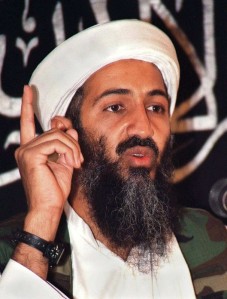 As Ambassador Dobrynin so ably points out, the failure of the 1975 US Congress in respect of Angola led directly to the Soviet ventures in the Horn of Africa, Afghanistan, and Yemen. All three those problem areas are with us still as points of upheaval on the globe. Afghanistan, for all practical purposes, created the phenomenon that was Osama Bin Laden (left) and would eventually become the springboard of the Bin Laden attack on the World Trade Center on 11 September 2001. The West still lives in the shadow of that event, which continues to define everything we have seen of the 21st Century.
As Ambassador Dobrynin so ably points out, the failure of the 1975 US Congress in respect of Angola led directly to the Soviet ventures in the Horn of Africa, Afghanistan, and Yemen. All three those problem areas are with us still as points of upheaval on the globe. Afghanistan, for all practical purposes, created the phenomenon that was Osama Bin Laden (left) and would eventually become the springboard of the Bin Laden attack on the World Trade Center on 11 September 2001. The West still lives in the shadow of that event, which continues to define everything we have seen of the 21st Century.
In 1992 Bin laden moved to the Sudan from where he watched the infamous Black Hawk Down event of 2-3 October 1993 in nearby Somalia, still destabilized since the Soviet-Cuban efforts of the late 1970s during the watch of Jimmy Carter. It was the bloodiest fight involving US personnel since the Vietnam War. President Clinton, the next Democratic Party president, promptly withdrew the US forces from Somalia after that event, confirming the impression of US weakness that Bin Laden already had. The instability in Somalia has remained to the present and US Special Forces and drones are still intermittently active in the region.
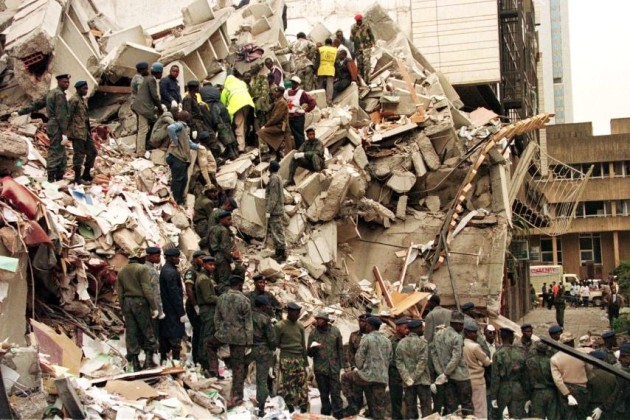
Bin Laden was diplomatically forced out of the Sudan on May 18, 1996 and moved back to Afghanistan where he sought the protection of the Muslim extremist Taliban. This is where he was located when the two US Embassy bombings (above) took place in Nairobi, Kenya and Dar-es-Salaam, Tanzania. Clinton’s response to this was two perfunctory cruise missile strikes on an aspirin bottling plant in Sudan and a suspected training compound in Afghanistan.
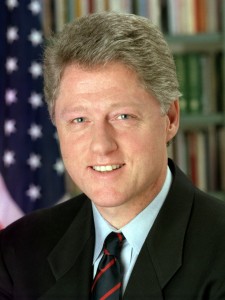 While the New York Times, a well-known Democratic Party mouthpiece, reported in somewhat matter-of-fact way on these strikes, this author vividly remembers British video reels of Bin Laden walking with a satellite phone amid the ruins of mud huts in Afghanistan and saying with a derisive grin on his face,”This is for Lewinsky”. He was implying that Clinton (left) only bombed the camp to get the US attention off his scandal about White House intern Monica Lewinsky, which had blown up days before. Yet, Clinton took no further action against Bin Laden. The reality is that he was by nature a fair weather manager and was already in his second term, and he elected to leave it as a problem for his Republican successor. The US eventually confessed in early 1999 that the factory in Sudan never was a terrorist nerve gas plant, as it had claimed, and paid financial restitution to Saudi businessman Saleh Idris for the damage to his plant. None of this helped the image of the United States.
While the New York Times, a well-known Democratic Party mouthpiece, reported in somewhat matter-of-fact way on these strikes, this author vividly remembers British video reels of Bin Laden walking with a satellite phone amid the ruins of mud huts in Afghanistan and saying with a derisive grin on his face,”This is for Lewinsky”. He was implying that Clinton (left) only bombed the camp to get the US attention off his scandal about White House intern Monica Lewinsky, which had blown up days before. Yet, Clinton took no further action against Bin Laden. The reality is that he was by nature a fair weather manager and was already in his second term, and he elected to leave it as a problem for his Republican successor. The US eventually confessed in early 1999 that the factory in Sudan never was a terrorist nerve gas plant, as it had claimed, and paid financial restitution to Saudi businessman Saleh Idris for the damage to his plant. None of this helped the image of the United States.
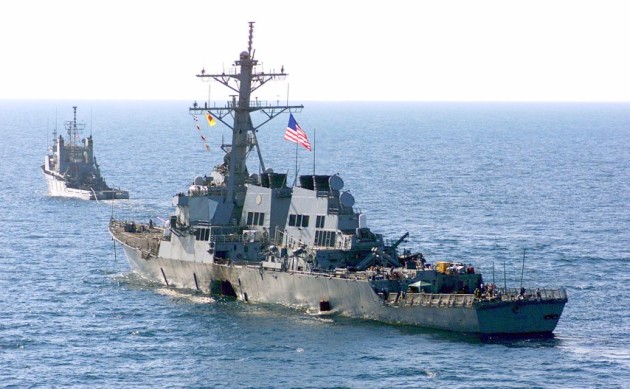
As a natural product of the Soviet-made and US-neglected upheavals in first Angola, and then Afghanistan and the Horn of Africa, Bin Laden took note of the US response. Then came the bombing of the USS Cole (above) on 12 October 2000 in the harbor of Aden, Yemen—yes, THAT Yemen that was on Dobryinin’s “Angola Consequence List”. Incredibly, it elicited zero response from the United States. With this calibration regarding the will of the United States, Osama bin Laden set in motion his plans for the 9//11 attacks.
Synopsis
The failure of resolve on the part of the United States Congress in Angola in 1975 led directly to the upheaval in Afghanistan and the Horn of Africa, and those upheavals gave us Osama bin Laden, the embassy bombings, the USS Cole, and 9/11. In the process it also turned Southern Africa upside down and resulted in an advanced country like South Africa being today little more than just another classic African Basket Case.
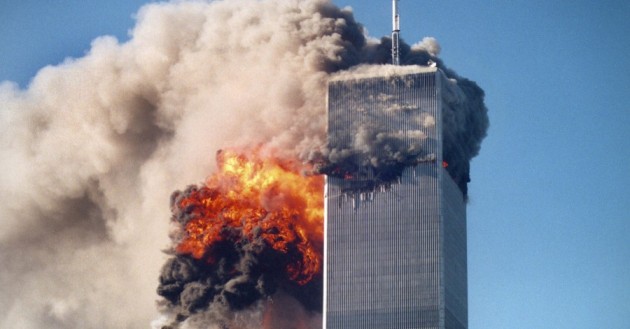
And this is how it came to be that a Lockheed C-141 Starlifter departed Charleston on 29 July 1975 into an international picture, and how four fuel laden airliners flew out of that very same picture on a beautiful blue sky morning on 11 September 2001 in the East of the United States and killed 3000 innocent Americans (above). Perhaps the surviving members of the 1975 US Congress can explain their thinking to the rest of us and to the loved ones of those who died.
To quote an honorable man and president of the United States once more,
A great nation cannot escape its responsibilities. Responsibilities abandoned today will return as more acute crises tomorrow.
Gerald Ford, President of the United States (1975)
He was right;…. painfully right.
The above series of events may be studied in more detail in the book AmaBhulu , which also provides all of the required references for all facts stated.
— Harry Booyens
